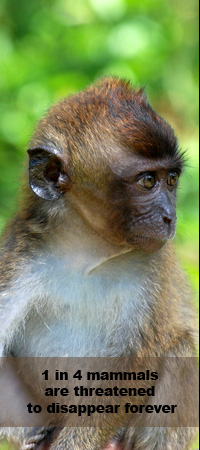|
Mammals evolved from a group of reptiles called the synapsids that arose 310 to 275 million years ago. From the synapsids, a branch called the therapsids appeared 275 to 225 million years ago, and it is during the early evolution of the therapsids that early mammal-like reptiles [a term now discouraged because none of them were actually reptiles] called cynodonts [group of largely carnivorous synapsids] arose.
These early cynodonts evolved mammalian-like teeth and a lower jawbone that foreshadowed the dentary bone that characterizes mammals and from their stock evolved the first true mammals.
The cynodonts dominated the world 250 million years ago but their era came to an end about 200 million years ago with the appearance of dinosaurs.
The numbers of species and the size of the remaining species were greatly reduced during that time and, for the next 135 million years, these early mammals played a very small role in the world. This time is often called the 'Dark Ages' of mammalian evolution. However, the evolution of the remaining mammals did not end. The demise of the dinosaurs 65 million years ago opened up the feeding niche that had been occupied by the dinosaurs and resulted in an explosive radiation for the mammals, who are now the dominant vertebrate group on land.
The Taxonomy of the Mammals
The Class Mammalia includes over 5000 species placed into two subclasses (Prototheira and Theira) and 26 orders. However, it must be noticed that systematists do not yet agree on the exact number or on how some orders and families are related to others.
Mammals used to be placed into three subclasses Prototheira (Egg-laying mammals), Metatheira (Marsupials), and Eutheria (Placental mammals). However, Metatheira and Eutheria are now considered Infraclasses and fall under the subclass Theira. The Order Artiodactyla (even-toed ungulates: antelope, hippos, deer, sheep, camels, pigs, cows, etc.) and Cetacea (whales, dolphins) are now falling under the Superorder Cetartiodactyla.
Subclass Prototheria (Egg-laying mammals)
The most ancestral forms among all mammals, today, are the egg-laying mammals; and only three existing species grouped into two families (Ornithorhynchidae and Tachyglossidae) and a single order, the Monotremata, remain. One of these three species is the Duck-billed Platypus (Ornithorhynchus anatinus), which is a small, semi-aquatic mammal that can only be found in the eastern part of Australia. This is the only representative of its family (Ornithorhynchidae) and genus (Ornithorhynchus), though a number of fossilised relatives have been found, some of them also in the Ornithorhynchus genus. The other two species are the Short- and Long-beaked Echinata or Spiny Anteaters (Tachyglossusaculeatus and Zaglossus bruijni).
Many characters of their therapsid ancestors can still be seen in egg-laying mammals including a complex pectoral girdle, laying of eggs rather than bearing live young, limbs oriented with humerus and femur held lateral to body, and a cloaca. Prototheira probably split from the lineage leading to other mammals sometime in the Mesozoic, 248 million to 65 million years ago. The skulls of monotremes look like those of birds. Modern monotremes do not have teeth as adults; sutures are hard to see; the rostrum is elongate, beak-like, and covered by a leathery sheath; and lacrimal bones are absent. However, monotremes have several important mammalian characters such as hair/fur, the ability to produce milk, a four chambered heart, a single dentary bone, and three middle ear bones.
Subclass (Theira)
Infraclass Metatheria (Marsupials)
Order Dasyuromorphia (numbat, extinct Tasmanian wolf)
Order Didelphimorphia (opossums)
Order Diprotodontia (10 families and 117 species) (kangaroos, wallaby, wombats, koalas)
Order Microbiotheria (only one living species, called "monito del monte" (Dromiciops australis))
Order Notoryctemorphia (marsupial moles)
Order Paucituberculata (shrew-like insectivores)
Order Peramelemorphia (bandicoots and bilbies)
Order Multituberculata (extinct rodent-like mammals with multi-cusped teeth that gave birth
to tiny, helpless young, similar to modern marsupials; first appeared in the Middle Jurassic,
and became extinct in the early Oligocene)
There are about 270 species of marsupials. Young marsupials are in an immature state, and most
females have pouches.
Infraclass Eutheria (Placental mammals)
Order Carnivora (carnivores: cats, bears [like the panda, polar bear, grizzly, etc.], weasels, pinnipeds, etc.)
Order Artiodactyla (even-toed ungulates: antelope, deer, camels, pigs, cows, sheep, hippos, etc.)
Order Cetacea (whales, dolphins)
Order Chiroptera (bats)
Order Hyracoidea (hyraxes)
Order Insectivora (insect-eaters: hedgehogs, moles, shrews)
Order Lagomorpha (rabbits, hares, pikas)
Order Macroscelidea (elephant shrews)
Order Perissodactyla (odd-toed ungulates: horses, rhinos, tapirs)
Order Pholidota (the pangolin)
Order Primates (apes, monkeys, lemurs, people)
Order Proboscidea (elephants, mammoths, mastodonts, etc.)
Order Rodentia (rodents: rats, mice, squirrels, gerbils, hamsters, etc.)
Order Sirenia (sea cows, manatees, dugongs)
Order Tubulidentata (aardvarks)
Order Xenarthra (formerly Edentata) (sloths, armadillos)
Order Condylarthra (Archaic hoofed mammals - extinct)
Order Creodonta (an extinct group of carnivores)
Order Desmostylia (an extinct group of marine mammals)
Order Embrithopoda (extinct rhino-like animals)
|
|
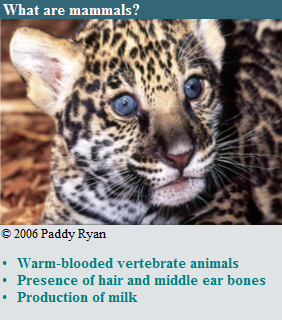

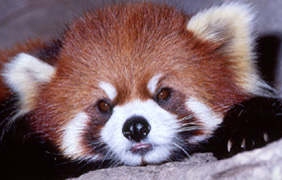
Less than 2,500 mature red pandas (Ailurus fulgens) remain in the wild © Paddy Ryan
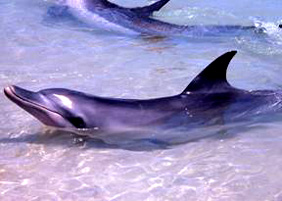
The Bottlenose Dolphin (Tursiops aduncus) is one of the most common and well-known dolphin species
© Paddy Ryan
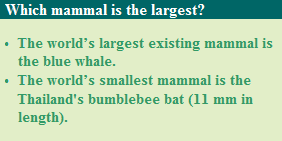
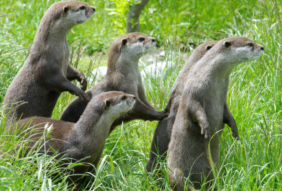
Asian small-clawed otters (Amblonyx cinereus) are threatened
by habitat destruction and environmental pollution, especially by organochlorines © Paddy Ryan
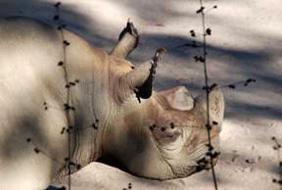
The current range of the African white rhino (Ceratotherium simum) is restricted to game preserves and national parks © Pierre Fidenci
|

